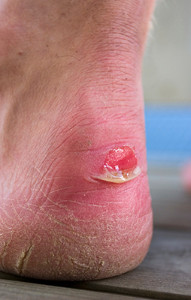A blister is a small pocket of fluid that can form on the foot. They vary in size and can occur for a variety of different reasons. On the feet, blisters can cause difficulty in walking, standing and exercising for long periods of time. Blisters can be caused by friction created by being on your feet for several hours a day, poorly fitting shoes, excessive moisture or perspiration and fungal infections. Some home treatments for blisters include cleaning it with antiseptic, making a small puncture in the blister with a needle, allowing the fluid to completely drain out and covering it with gauze or a bandage. There are also a couple ways to prevent yourself from getting a blister. To do this, it is necessary to be able to assess the cause of the blister. If it is due to friction, then make sure you are wearing properly fitted shoes. If you are active in sporting activities, make sure that you keep your feet dry and apply foot powder as to avoid the feet getting sweaty. If you have developed a blister, it is recommended that you consult with a podiatrist to figure out the best treatment method.
They vary in size and can occur for a variety of different reasons. On the feet, blisters can cause difficulty in walking, standing and exercising for long periods of time. Blisters can be caused by friction created by being on your feet for several hours a day, poorly fitting shoes, excessive moisture or perspiration and fungal infections. Some home treatments for blisters include cleaning it with antiseptic, making a small puncture in the blister with a needle, allowing the fluid to completely drain out and covering it with gauze or a bandage. There are also a couple ways to prevent yourself from getting a blister. To do this, it is necessary to be able to assess the cause of the blister. If it is due to friction, then make sure you are wearing properly fitted shoes. If you are active in sporting activities, make sure that you keep your feet dry and apply foot powder as to avoid the feet getting sweaty. If you have developed a blister, it is recommended that you consult with a podiatrist to figure out the best treatment method.
Blisters are prone to making everyday activities extremely uncomfortable. If your feet are hurting, contact Donald Manger, DPM of Associated Podiatric Physicians, PA. Our doctor can provide the care you need to keep you pain-free and on your feet.
Foot Blisters
Foot blisters develop as a result of constantly wearing tight or ill-fitting footwear. This happens due to the constant rubbing from the shoe, which can often lead to pain.
What Are Foot Blisters?
A foot blister is a small fluid-filled pocket that forms on the upper-most layer of the skin. Blisters are filled with clear fluid and can lead to blood drainage or pus if the area becomes infected.
How Do Blisters Form?
Blisters on the feet are often the result of constant friction of skin and material, usually by shoe rubbing. Walking in sandals, boots, or shoes that don’t fit properly for long periods of time can result in a blister. Having consistent foot moisture and humidity can easily lead to blister formation.
Prevention & Treatment
It is important to properly care for the affected area in order to prevent infection and ease the pain. Do not lance the blister and use a Band-Aid to provide pain relief. Also, be sure to keep your feet dry and wear proper fitting shoes. If you see blood or pus in a blister, seek assistance from a podiatrist.
If you have any questions, please feel free to contact our office located in Hamilton Township, NJ . We offer the newest diagnostic and treatment technologies for all your foot care needs.